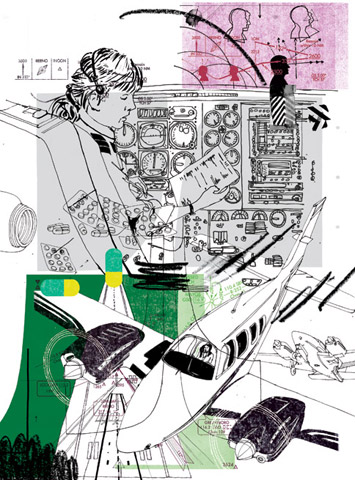Safety Pilot Landmark Accident: Perception is not reality
This was not the place to be
 Illustration by Neasden Control Centre
Illustration by Neasden Control Centre
Too many times we are told that “perception is reality.” Perhaps it’s true in politics or public relations—but in aviation, reality beats perception every time. The heart of primary instrument training is to ignore the perceptions of the body and be sure the eyes have it. It’s good to review the basics regularly, lest we be led astray by bogus sensations. It’s also important to look at the big picture and figure out if we’re up for a big challenge. Our ego’s perception may say one thing, but personal reality often depends on so much more.
The flight. The Beech Baron 58 and pilot had been chartered on March 30, 2011, to fly a passenger from Winston-Salem to Wilmington, North Carolina, and back at the end of the day. The pilot’s morning started early with an Internet weather query around 4:30 a.m. Eastern time. The Baron arrived at Winston-Salem at 7:39 a.m. from the charter company’s home base in nearby Raleigh-Durham, North Carolina. The pilot and passenger departed about 8:40 a.m.
The return IFR flight from Wilmington started around 4:20 p.m. after the pilot checked the weather several times. She asked a fellow company pilot to help her find a legal alternate. The flight path lay between two large weather systems with moderate rain and thunderstorms to the east; there were low ceilings and visibilities on the western portion of the route. The weather was hovering around landing minimums for much of the day in Winston-Salem. The forecast called for the possibility of moderate or greater turbulence and wind shear near 3,000 feet over the area.
Arriving in the Winston-Salem area the pilot contacted Greensboro Approach at 5:04 p.m. The controller advised that the Winston-Salem visibilities were varying between three-quarters and one mile and the ceiling was overcast at 100 feet. This was below landing minimums and, according to FAR Part 135 (air taxi regulations), pilots are prohibited from beginning the approach. At 5:08 p.m. the pilot requested and was cleared into holding at a nearby intersection to consider the options and she asked to be notified if the weather improved. There was some discussion about diverting to other airports 30 to 40 miles from Winston-Salem, where the ceilings were above 300 feet, but the pilot declined and the flight entered holding at 5:25 p.m.
Over at Greensboro, about 13 miles to the east, the weather also was low, but flights were landing on Runway 5L. Visibility was varying between one quarter and one half mile with a cloud base report of about 50 feet. At 5:34 p.m., the pilot contacted Greensboro Approach and said that Greensboro would be an acceptable alternative if the weather conditions were “good.” The controller issued radar vectors to Greensboro.
At 5:35 p.m., the pilot was advised that the ceiling at Greensboro was overcast at 100 feet, surface winds northeast at 5 knots, and tower visibility at the time was running about one-quarter mile, to which the pilot responded, “That’s not going to help much.” Two minutes later, at 5:37, the controller asked the pilot her intentions. The pilot responded that if no other aircraft were arriving at Greensboro, she would return to the previous holding pattern. The controller responded, “Everybody’s getting into Greensboro, nobody’s gone around yet.” The pilot replied, “Alright, let’s do it.” The Baron was provided vectors for the ILS approach to Runway 5L at Greensboro.
At 5:40 p.m. the flight was cleared down to 3,000 feet and vectored to intercept the localizer. The aircraft passed through the localizer from the northwest one minute later and then reintercepted the course from the southeast. The controller offered assistance but the pilot declined. After becoming established on the localizer and cleared for the approach, the Baron descended to the published minimums of 2,500 feet for the intermediate segment of the approach. The tower advised that the Runway 5L runway visual range (RVR) was 4,000 feet and that the Baron was number two to land behind an Embraer 145 on a one-mile final. Published landing minimums for Runway 5L included a decision altitude of 200 feet and a minimum RVR of 1,800. Because visibility is considered controlling, it was legal to begin the approach.
Things began to unravel here. According to the NTSB report, “At 5:44:33 p.m. about 0.5 nautical miles from the final approach fix, the airplane began descending from 2,500 feet, and crossed the fix about 200 feet below the published intercept altitude…over the course of about 2 minutes, the airplane descended to 1,300 feet, and remained below the glideslope for the final 8 nautical miles of the approach.” The Baron descended to only 400 feet agl while still three miles from the runway threshold. At 5:45:42 p.m. the flight began to climb, just as the tower controller issued a low altitude alert. The pilot responded, “We’re going around.”
The assigned missed approach was to fly runway heading, and climb to 4,000 feet, which the pilot acknowledged. There were no further transmissions and after reaching only 1,600 feet at 5:45:52, the aircraft descended. The Baron crashed two miles from the runway and about 800 feet left of the localizer. There were no survivors.
The pilot. The 49-year-old pilot held an airline transport pilot certificate issued in 2008. Her private pilot certificate was issued in 1984. She added an instrument rating in 2000 with a commercial pilot certificate in 2001. Second-in-command (SIC) type ratings were issued for the Lear 45 and Beechjet 400 in 2007. The pilot was qualified to act as PIC in the Baron exactly one year prior to the accident, on March 30, 2010.
At the time of the accident the pilot had 2,884 hours of flight experience, 856 hours of which were acting as PIC. She had logged 117 hours in the Baron, with 95 hours as PIC. Since her last instrument proficiency check in October 2010 four instrument approaches and five hours of instrument flight experience were recorded.
 The autopsy revealed that the pilot had taken a number of prescription medications for migraine headaches. They may, as noted by an NTSB medical officer, “cause sedation and may impair mental and/or physical ability required for the performance of potentially hazardous tasks.” The report further noted, “No blood sample was available for toxicology testing, therefore the precise blood levels, accurate predictions about a potential level of impairment, or knowledge about timing of medication ingestion could not be determined.”
The autopsy revealed that the pilot had taken a number of prescription medications for migraine headaches. They may, as noted by an NTSB medical officer, “cause sedation and may impair mental and/or physical ability required for the performance of potentially hazardous tasks.” The report further noted, “No blood sample was available for toxicology testing, therefore the precise blood levels, accurate predictions about a potential level of impairment, or knowledge about timing of medication ingestion could not be determined.”
The aircraft. The 1975 Baron 58 was equipped with a Garmin GNS 530W (GPS receiver) and complied with all maintenance requirements at the time of the accident. An autopilot was installed, as required for single-pilot operations under Part 135. An unapproved terrain avoidance warning system also was installed but it is unknown whether it was in use. No aircraft discrepancies were identified.
NTSB findings. The probable cause(s) of this accident was determined as: “The pilot’s spatial disorientation due to a somatogravic illusion while conducting a missed approach in instrument meteorological conditions, which resulted in the airplane’s descent into objects and terrain.”
Somatogravic illusion is the sensation that the pitch attitude is much steeper than it actually is. It can occur when—during a missed approach, for example—power is rapidly applied. An airplane will naturally pitch up with power application, which adds to the illusion. A pilot may overreact by lowering the nose too far and flying into the ground.
Analysis. Perhaps there’s more to this than just somatogravic illusion. The medications, speculatively, may have been a factor despite the pilot having made two ILSs earlier in the day. Fatigue and stress should also be considered. The pilot had been up since 4:30 a.m. and while she may have been able to nap at Wilmington, the quality of FBO rest is always in question. She also was consciously thinking about the weather and wanted to get her charter customer back to his destination. The charter business depends on providing excellent service to the customer and pilots try very hard to please.
An experienced professional pilot usually will not miss a localizer intercept and almost certainly will not descend below the glideslope inside the final approach fix. Clearly, she recognized that something was wrong and started corrective action by initiating the miss. Unexpected wake turbulence from the preceding Embraer 145 could have complicated a go-around but that is also conjecture, and there were no indications that the flight experienced any sort of upset.
Based on the transcript, the pilot seemed uncertain about the Greensboro weather and when the controller noted that nobody else was missing approaches, it was a natural—if somewhat impulsive—decision to give it a go. In the 20 minutes preceding the accident, six other aircraft successfully completed the approach, so that’s a good indication that it was flyable. Mix fatigue, stress, possibly some impairment from medication, and really low weather, and the accident chain is nearly in place. All that’s needed is perhaps a moment’s inattention and some vertigo. It can take half a minute or more to recover once becoming disoriented—more time than usually is available.
Obvious guidance is to pay extremely close attention during approach. The eyes must be locked on the primary flight instruments with the appropriate segment altitudes clearly in mind. Write them down on a Post-it note if needed. On the miss, nothing else is as important as establishing a positive climb and getting away from the ground. But more strategically, was her “inner voice” talking to her, suggesting that this may not have been the place to be?
Summary
- A Beech Baron 58 is scheduled to fly a round-trip charter flight from Winston-Salem to Wilmington, North Carolina.
- Returning to Winston-Salem, weather is below minimums for an approach and the flight holds briefly before diverting to Greensboro.
- On a missed approach the pilot experiences somatogravic illusion. The aircraft crashes two miles from the runway. There are no survivors.


